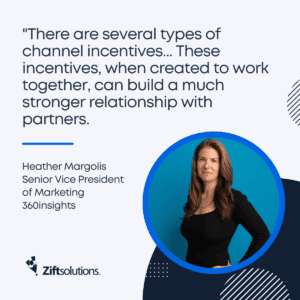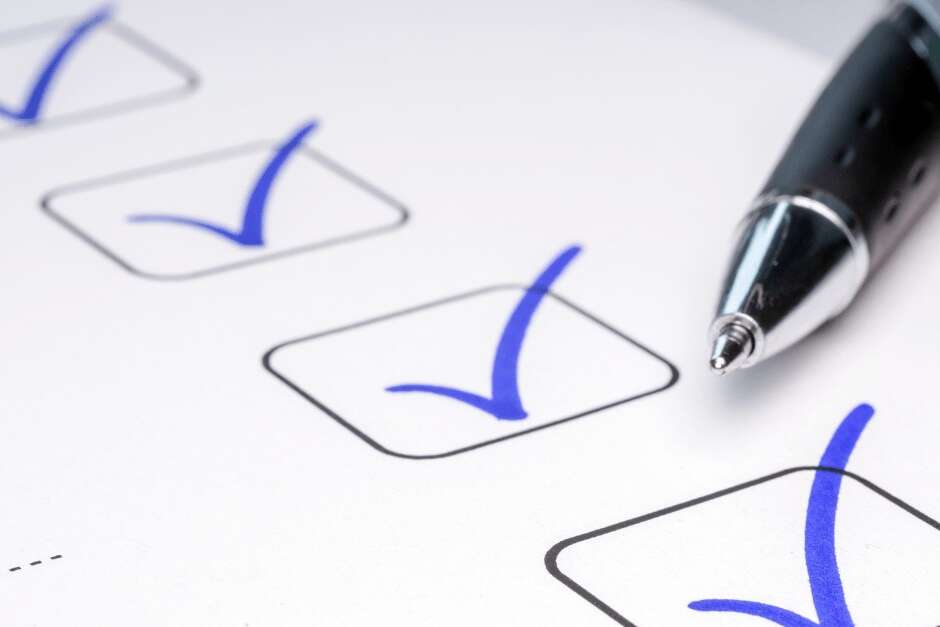- Channel incentive programs should prioritize long-term incentives to stay competitive.
- Channel incentive programs should align partner goals and supplier goals to inform incentives.
- Channel incentive programs should design incentive types to work together.
- Channel incentive programs should avoid creating incentives into entitlements for partners.
- Channel incentive programs should incentivize roles beyond partner salespeople.
- Channel Incentive programs should incentivize pre-sale and post-sale activities.
6 Best Practices for a Successful Channel Incentives Program
Partner ecosystems are often a critical path to revenue growth for suppliers, with channel sales making up 75 percent of global commerce. An effective channel incentives program is a core element of a thriving partner ecosystem and ensures high-quality channel management.
What are the top best practices for a successful channel incentives program? To answer this question, we spoke with eight industry experts. Our panelists include:
- Heather K. Margolis, Senior Vice President of Marketing for partner engagement and business optimization company 360insights
- Anita Sharifi, Vice President, Co-Founder & President for corporate gifting platform DONO
- Nichole Gunn, Chief Marketing Officer for incentive rewards program consultancy and incentive management software provider Incentive Solutions
- Eli Jacobson, Director of Channel Strategy & Operations for deep observability company Gigamon
- Cyndi Radke, Strategic Advisor for global employee experience solution provider ITA Group
- Jasmina Muller, Chief Ecosystem Officer for enterprise co-selling platform PartnerTap
- Stacy Conrad, Senior Vice President of Channels for managed services provider TPx
- Anthony D’Angelo, Head of Customer Growth for partner relationship management (PRM) and channel management platform provider Zift Solutions
Interested in jumping ahead? Check out six best practices for channel incentives programs to use in 2023:
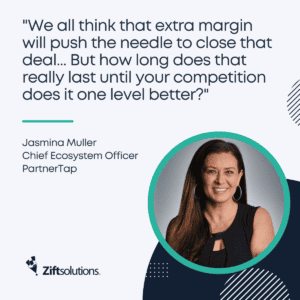
What are Channel Incentives?
Channel incentives are rewards from suppliers and vendors for channel ecosystem partners to engage them in promoting and selling suppliers’ services, solutions and products.
What are the Benefits of Channel Incentives?
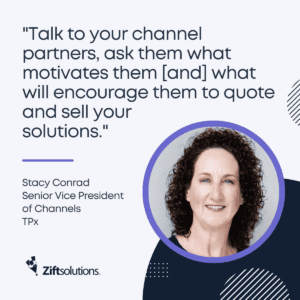
Channel incentives provide channel partner recruitment, partner engagement and business development benefits for partner ecosystems, including:
- Driving partner performance and sales pipeline
- Boosting customer satisfaction
- Increasing supplier and partner revenue
- Earning partner loyalty for select providers
- Prioritizing vendor solutions and services
- Differentiating suppliers from their competition
- Gaining partner mindshare for vendors
What are the Types of Channel Incentives?
Various channel incentives exist depending upon their application for a specific partner type and vendor end goals. The most common types of channel incentives include
- Channel sales incentives – Sales-oriented incentives for transacting partners are the most common type of partner incentive within partner ecosystems. Channel partner sales reps are rewarded based on sales volume, margin, product type, incremental overall growth goals, target industry growth goals and other sales-focused benchmarks. Partners receive single-use debit cards, gift card rewards, points-based merchandise rewards, incentive travel rewards, awards to publicize sales success and other forms of compensation.
- Channel SPIFFs – SPIFFs (Sales Performance Incentive Funds) are well-known channel sales incentives that provide an individual partner sales rep or the partner company with a monetary reward based on a percentage of the deal closed. SPIFFs are typically short-term promotions that target specific business initiatives, such as growing the market share of a new product or increasing customers in an underserved industry vertical.
- Channel marketing incentives – Channel marketing incentives encourage channel partners to co-market supplier solutions and build the supplier’s brand.
- Market development funds (MDF) – MDF is funding the supplier provides to a partner to help that specific partner market and promote the supplier’s products and services. Access to MDF is typically earned by achieving a program tier or proving ROI for the activity. MDF is usually allocated discriminately, tracked carefully and may have revenue requirements from a partner given the MDF to adhere to receive MDF in the future.

- Channel enablement, training and certification incentives – Training and certification-focused incentives reward partners for completing sales, marketing, product and technical training courses, taking quizzes and achieving certifications available in a program’s learning management system (LMS). These incentives also reward attending in-person and online educational events, lunch and learns, tradeshows and webinars. These incentives include points-based rewards, gift cards and access to higher tiers in tiers-based programs.
- Channel rebates – Channel rebate programs create demand and influence end customer buying decisions, which can push a supplier’s solution set over the line with decision-makers. Partners are typically rewarded based on order size or frequency for a particular product set.
- Channel referral incentives – Referral incentives reward channel partners for deal registration and identifying possible sales opportunities. Like other sales-based incentives, they take the form of points-based rewards, gift cards, debit cards and incentive travel rewards.
- Loyalty incentives and partner retention – Channel loyalty incentives are designed to retain high-performing channel partners who have already reached and claimed other incentive rewards. Their primary purpose is to keep your most valuable partners away from competitive partner programs. Instead of providing monetary compensation for growth, the supplier offers financial compensation for retaining existing revenue across specific periods with established thresholds around contract renewals for end customers.
6 Best Practices for a Successful Channel Incentives Program
Our expert panel identified six best practices companies should adopt in designing their channel incentives program.
1. Prioritize Long-Term Incentives to Stay Competitive
In our recent blog on 2023 channel program predictions, our panelists at the time predicted vendor partner funds would move to long-term investment versus short-term incentives, and our current panel confirms this trend.
Our panel cautions against focusing program resources on short-term sales incentives like SPIFFs for transacting partners. Instead, they advocate long-term relationship development, such as loyalty incentives[DC5] , rebates that extend through partners to their end customers, access to universally applicable industry education and more.
“We all think that extra margin will push the needle to close that deal,” says PartnerTap’s Muller. “We put in that 3X, 5X monthly incentive on closed deals [It] was a short-term strategy to gain and recruit new partners. But how long does that really last until your competition does it one level better? Then you have the constant ’back and forth’ of adding additional margin points here and there [and ultimately]; it doesn’t differentiate you.”
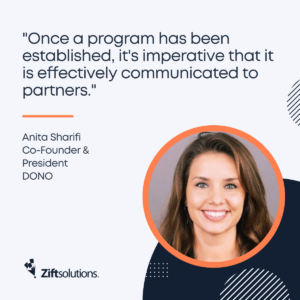
“Why not look at the long term, where you will see the benefits for both companies? Partners want to work with qualified opportunities [and] they want to be able to trust that they will be working alongside a ‘teammate.’”
Incentive Solutions’ Gunn notes that SPIFFs can still be effective, but her clients are incorporating long-term incentives such as loyalty programs for rewards for cumulative performance over time. “We have found the best success in beginning with SPIFFS, [with] the long-term goal of loyalty incentives,” says Incentive Solutions’ Gunn. “We tend to take a tiered approach, recommending points [and] online rewards for the mid 60 percent of channel partners, and group travel for the top 20 percent of [distributors] and their top dealers.”
Gunn outlines how incentive management software provider Incentive Solutions approaches a successful sales incentive program. “The best approach [is] percentage of sales [revenue], percentages from our clients to their distributors, and then a [percentage] of sales revenue from the distributors for their dealers, and then rebates to the consumer,” says Gunn. “This multi-incentive approach works well, as you’re creating brand familiarity and loyalty through the channel. Once a client collects the dealer and consumer data, they can open lines of communication [with] them. We highly recommend a multi-touch approach to take advantage of the opportunity to build a connection.”
2. Align Partner Goals & Supplier Goals to Inform Incentives
Previous panels have stressed the need for alignment between partners and suppliers, and this panel is no different. Goal alignment is a core requirement for a successful partnership between a supplier and their partners.
“To build a successful partner program, start by aligning your business goals and objectives with partner preferences,” said DONO’s Sharifi. “Maintain constant communication with your partners to make frequent adjustments and ensure that your program is always improving.”
PartnerTap’s Muller also recommends starting a dialog with partners to ensure incentives are meaningful. “The best way to provide the best incentives for the partner ecosystem is [to] ask them,” said PartnerTap’s Muller. “Seriously, [ask] what drives them [and] what they need to be successful for their business.”

TPx’s Conrad agrees, noting that communicating with partners will ensure your incentives align with how they do business. “Talk to your channel partners, ask them what motivates them [and] what will encourage them to quote and sell your solutions,” says TPx’s Conrad. “You must also understand their business model to make sure the incentives benefit the sellers.”
3. Design Incentive Types to Work Together
Our panel encourages programs to leverage multiple types of incentives in concert to drive toward your objective.
“There are several types of channel incentives, including MDF [and] BDF, points-based solutions, rebates and SPIFFs, to name a few,” says 360insights’ Margolis. “These incentives, when created to work together, can build a much stronger relationship with partners. For instance, if your points-based program incentivizes the right sales and marketing activities and your MDF [and] BDF program provides funding for these activities, your partners will be driving more predictive revenue in a few months.”
Creating incentives that work in tandem also requires that you coordinate implementation across your organization. “The most common challenge we see is that these different types of incentives are often run by different lines of business who may or may not collaborate well,” says Margolis.
Driving channel sales behavior also may require you to offer complementary incentives. “One common challenge is most incentive programs reward partners [for selling] net new business and growing the channel, yet we are also still expecting them to focus on renewals and upsells,” says TPx’s Conrad. You need to reward partners for both.
4. Avoid Creating Incentives into Entitlements
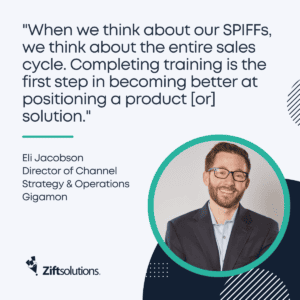 Programs need to be wary of making incentives the primary lever for bringing in sales or literally overcompensating for deficiencies in the offer or organization. ITA Group’s Radke explains: “[Program] challenges include ’throwing’ cash or other incentives at a problem without proper understanding and thus making the award an entitlement.”
Programs need to be wary of making incentives the primary lever for bringing in sales or literally overcompensating for deficiencies in the offer or organization. ITA Group’s Radke explains: “[Program] challenges include ’throwing’ cash or other incentives at a problem without proper understanding and thus making the award an entitlement.”
Zift Solutions’ D’Angelo agrees that making incentives an expectation on every sale will eventually backfire. “A sales incentive should be a reward for closing a deal of a certain size, target vertical or another criterion,” D’Angelo says. “Paying SPIFFs on every deal is not sustainable, and when you pull them back, partners that rely on SPIFFs may interpret the change like a compensation cut and stop sending you deals altogether.”
5. Incentivize Roles Beyond Partner Salespeople
Partner programs commonly incentives sales partners, but they are just part of the organization that sells and services the account. 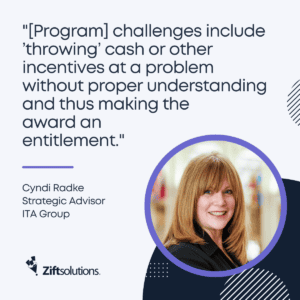
Gigamon’s Jacobson advocates for compensating other roles inside the organization. “What separates us [Gigamon] on the sales side is that we’ve directed some of our incentive budget to the Sales Engineers (not just partner sellers),” says Gigamon’s Jacobson. “They play such an important role in the sales cycle and should be incented to successfully complete training and drive an opportunity to a successful close.”
DONO’s Sharifi echoes the same sentiments to retain partner engagement. “Involve key stakeholders from all parts of the organization and offer a range of rewards and recognition options to keep partners motivated and engaged,” she says.
6. Incentivize Pre-Sale & Post-Sale Activities
Our panel also recommends extending incentives beyond wins to pre-sales and post-sales activities. “Our clients who are successful not only incentivize the end result, or sale, but also incentivize the activities that lead to the sale,” says 360insights’ Margolis. “By providing some sort of incentive throughout the funnel, so to speak, you’re motivating partners to do the things that will help them drive business for the longer term.”
Incentives should ideally extend outside sales-oriented activities to marketing, training and collaboration activities that take up partners’ time but are invaluable for suppliers.
Gigamon’s Jacobson says his company provides incentives for completing training. “When we think about our SPIFFs, we think about the entire sales cycle. Completing training is the first step in becoming better at positioning a product [or] solution. Once there is a foundational knowledge of the solution, this leads to deal registrations and eventually the successful closure of opportunities,” he says.
Jacobson also points to incentivizing marketing activities, like case studies.
Incentive Solutions’ Gunn agrees, noting her clients often award points “for marketing tasks like Google reviews, participating in surveys or joining client panels to help test products and provide much-needed feedback.”
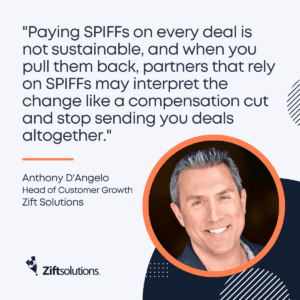 Startup and household channel companies can use the above best practices for their channel incentives program to improve engagement with their ecosystem partners and increase their bottom line.
Startup and household channel companies can use the above best practices for their channel incentives program to improve engagement with their ecosystem partners and increase their bottom line.

